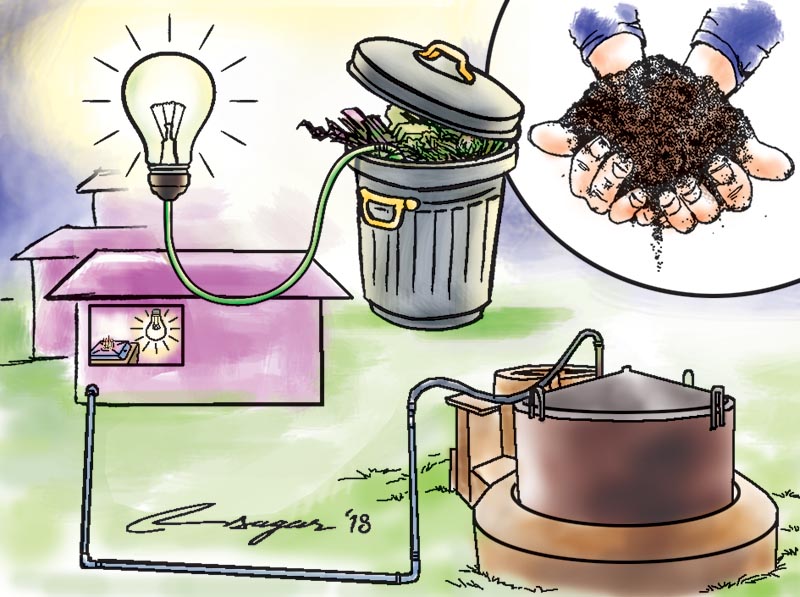Waste management: From trash to treasure
Municipal Solid Waste is a huge, renewable source of energy. Across the world, various methods and technologies have been adopted to convert waste into energy. We must identify which technique suits best in Nepal
Municipal Solid Waste (MSW) is a huge, renewable source of energy. Waste to Energy (WTE) is an efficient and viable solid waste management technique. Most of the MSW originates at households and hotels. There are some types of kitchen waste which can be easily converted into energy. This energy can be in the form of compost fertiliser, liquid fertiliser, biogas and electricity. This, however, requires various processes. Other imperishable and plastic trash can be converted into usable form of energy, including electricity, fuel and heat.
One of the ways of managing waste is incineration. However, viability and long-term impacts are major challenges. Emissions from such plants include dioxins, heavy metals and other toxic pollutants. Actually, the main objective of incineration is not to produce electricity; it is to manage solid waste. Hence, it is always good to recycle waste rather than incinerating it. The waste that can’t be recycled only should be incinerated to generate electricity. Modern technologies use pollution control innovations, which largely reduce emission of toxic pollutants. Another advantage of incineration is we can use the slag for construction of roads and making bricks. WTE researchers are working on making more refined plants. The plant now in the construction phase in Ethiopia is expected to meet the European standard of air emission. Such plants are established mainly in those countries where land is very valuable. In cities where land is limited, WTE incineration saves space, generates electricity, prevents formation of leachate and reduces the release of methane into atmosphere.
Another way of solid waste management is generating biogas from putrescible waste. Latest research on WTE says an efficient biogas system of single unit can produce 2 to 3 hours of cooking gas from only 2kg of kitchen waste. This type of biogas plant can reduce the use of LPG by 50-60 per cent. Organic solid waste management can be done via aerobic composting. Another example of WTE is anaerobic composting—conventional but effective and easy technology. In this composting, waste is converted into compost as well as biogas biologically.
Another WTE technique is pyrolysis. Waste is thermo-chemically converted into liquid fuels. Plastic waste is heated at a high temperature in the absence of oxygen, which produces mixture of oil. Since oil is not renewable, the reduction in consumption of fuels by recycling the plastic-based materials is a sustainable option. This can then be used to produce diesel and petrol as well as generate electricity.
Denmark is a very good example when it comes to managing waste through incineration. Denmark incinerates municipal waste to generate around 5 per cent of total electricity demand and 20 per cent of total district heating. Amager Bakke incinerator in Copenhagen is the most energy efficient plant with high environmental profile and low emission.
Singapore is another successful country in MSW management. Singapore recycles 60 per cent of total MSW and the remaining waste generates electricity which is 3 per cent of total electricity demand. More than 28 per cent of plastic waste is recycled in the US. Ethiopia is another country doing well in MSW management.
In Nepal, however, we have very poor MSW management techniques. More than 80 per cent of the waste is dumped at landfill sites. The estimated amount of MSW across the country is 2,000 tonnes, while the Kathmandu Valley alone generates 500 tonnes of solid waste each day. The waste from the Kathmandu Valley alone can generate up to 6MW of electricity.
Landfill fires and open burning of waste are a constant problem in Nepal. Using landfill as a primary waste disposal method is neither sustainable nor good for environment. It produces leachate, a liquid containing toxic compounds that disperses around landfill areas. In waste management, landfilling is the least preferred option. Generally, waste that is not reusable or recyclable is dumped into the landfill. If we can’t establish incinerator plants and other WTE plants, we can manage waste in such a way that only 30 per cent of the non-recyclable plastic trash is dumped into the landfill.
The Kathmandu Metropolitan City successfully tested a biogas plant two years ago. This plant has capacity of producing 96 kg of gas, 300 kg of liquid fertiliser and 13,500 litres of purified water. A similar project started in Nawalparasi has the capacity of producing 2 tonnes of cooking gas and 25 tonnes of organic fertiliser daily by processing 40 tonnes of organic material. So to turn trash into treasure, firstly we need to figure out the amount of trash and types of waste we produce.
The most significant challenge to WTE technology adoption is awareness that waste can be used as source of clean energy. So we have to first identify what our scenario is.
If we can’t maintain basic standard of air pollution, incinerator plants may not be a good option. We must be aware of the fact that any proposed incinerator plant must meet efficiency and climate goals. For effective waste management, government should be ready to spend sufficiently. After that, it must identify which technique is best in our scenario. It’s time we started focusing on turning trash into treasure.
Bhatta is an electrical engineer






